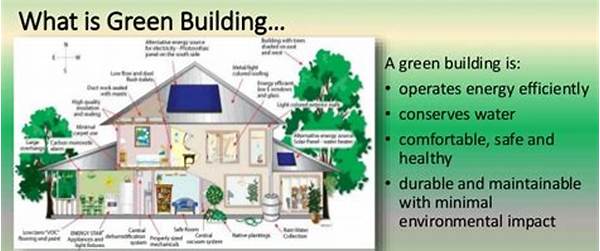Once upon a time, in a bustling city filled with concrete jungles and hustle-bustle, there was a visionary architect named Sam. Sam was not your everyday designer; he was a dreamer with a mission to make the world a better place. Sam was head over heels in love with the concept of green building design principles, believing it was the key to a sustainable future. Armed with his blueprints and boundless enthusiasm, Sam embarked on a quest to revolutionize city landscapes.
Read Now : Economical Living Reduced Hoa Costs
The Essence of Green Design
Sam’s journey began at a local community meeting, where he passionately pitched the idea of eco-friendly structures. “Hey folks, imagine buildings that breathe, structures that are in harmony with nature!” he exclaimed. The crowd was intrigued. Sam explained that green building design principles include energy efficiency, water conservation, and the use of sustainable materials. It’s all about creating spaces that are not just habitats but also help maintain the balance of our ecosystem. These principles are not merely guidelines but a lifestyle, fostering a reduced carbon footprint and increased well-being for tenants. Sam painted a picture of a future where concrete and greenery coexisted seamlessly, and the audience, excited by his vision, began to see the possibilities that these principles could unfold.
Sam’s enthusiasm was infectious. He started implementing these ideas in small projects, turning plain structures into living, breathing entities. Roof gardens blossomed, sunlight flooded through clever designs, and recycled materials gave new life to old constructs. The green building design principles were no longer just a concept; they were a reality, a movement taking shape one brick at a time.
Green Building Principles Explained
1. Eco Materials Galore: Using recyclable or sustainable materials is key. Green building design principles say goodbye to harmful processes and hello to things like bamboo or reclaimed wood.
2. Energy Efficiency Wins: Solar panels, LED lights, and all that jazz! Save power to save the planet.
3. Water Whisperer: Rainwater harvesting and low-flow fixtures are in. Conserve each drop like a boss.
4. Nature Vibes: Integrate greenery around and inside. Biophilic design is the insider secret.
5. Waste Not, Want Not: Recycling isn’t just cool; it’s essential. Less waste, more wins!
Strategies for Implementing Green Principles
Sam’s blueprints now captured the city’s imagination. Implementing these green building design principles required dedication and a paradigm shift in thinking. Sam became a storyteller, educating the masses about the small yet impactful changes they could make. “Imagine a world where energy is renewable, waste is minimized, and every building breathes life,” he’d narrate, bringing people together to brainstorm ideas for implementing these strategies.
Communities became champions of this new faith. Architects collaborated, sharing insights and adapting plans to local conditions. The journey was not just about building eco-friendly structures but fostering a community that understood and respected ecological limits. Sam initiated workshops to trade tips and tricks, encouraging everyone to be part of the green revolution. And slowly but surely, green building design principles became the cornerstone of urban development.
Read Now : Low-cost Landscape Care Ideas
The Roadblocks and Triumphs
But the path was not without its challenges. Skeptics raised eyebrows, questioning the costs and feasibility. Yet, Sam was relentless. “It’s about long-term gain folks! The investment today saves tomorrow’s planet,” he’d remind them with a grin. Funding was sometimes elusive, planning permissions a headache, but Sam’s passion turned obstacles into stepping stones.
His projects became case studies, highlighting that green building design principles could be both economically viable and environmentally necessary. Sustainable designs attracted media attention, inspiring others globally to follow suit. The triumph wasn’t just measured in buildings but in shifting perceptions worldwide. People began to accept that eco-friendly living wasn’t just a fad, but a necessary evolution.
Community Reactions
As the concept spread, neighborhoods started adopting these humane structural customs, transforming barren spaces rapidly into lush, green paradises, in line with the pivotal green building design principles. Ignoring initial skepticism, communities witnessed firsthand how incorporating a harmonious dose of greenery into urbanity enhanced quality of life. Kids enjoyed cleaner air as they played, adults found solace in natural ambient settings. Pretty soon, others wanted in on the secret sauce too!
Witnessing these positive changes, skeptics became believers, realizing the lifestyle and environmental benefits embedded in green building design principles. The sense of achievement not only validated Sam’s relentless strive but also strengthened community bonds. People now communicated more, exchanging pleasantries at neighborhood parks where barren lands existed earlier. And there, a sustainable lifestyle, vividly shaped by green ideals, was achieved.
Future Forward
The success stories surrounding green building design principles turned into a movement, pushing city planners and government policies towards more resilient designs. Sam’s efforts proved to be a catalyst for a much larger revolution. With a smile reflecting fulfillment and hope, Sam gazed upon the superb transformation – a vivid demonstration of how determination coupled with green building design principles could indeed redefine futures.
Wrap-Up and Takeaway
Reflecting on his journey, Sam couldn’t help but smile. Through sheer tenacity and belief in green building design principles, he not only built eco-friendly structures but reshaped community thoughts, uplifting a new generation of eco-focused minds. The story of perseverance displayed how embracing ecological sustainability ultimately leads to grand architectural innovations. As he looked upon the urban oasis, deeply within, Sam cherished the immense impact of his vision upon societies worldwide.
